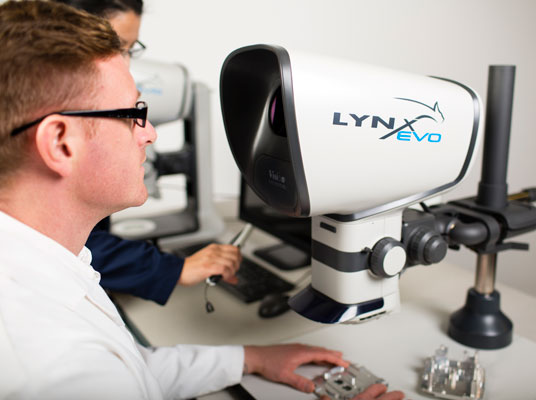Lean manufacturing is a methodology that focuses on minimizing waste while maximizing efficiency and value. It’s a holistic approach that emphasizes continuous improvement, employee involvement, and a commitment to delivering quality products. In this context, the role of technology, specifically eyepiece-less microscopes, becomes pivotal. This article explores how Vision Engineering’s eyepiece-less microscopes can assist in the adoption of lean manufacturing processes, contributing to increased efficiency, reduced waste, and improved overall productivity.
Understanding Lean Manufacturing: A Brief Overview
Lean manufacturing, often inspired by the Toyota Production System, is founded on the principles of identifying and eliminating waste in all forms. These wastes, commonly referred to as the “Seven Wastes,” include overproduction, waiting, transportation, over processing, excess inventory, defects, and motion. Lean manufacturing aims to create value for customers while minimizing resources and efforts that do not contribute to that value.

The Role of Ergonomic Eyepiece-less Microscopes in Lean Manufacturing:
Ergonomic microscopes play a crucial role in supporting lean manufacturing principles. Vision Engineering, a leader in ergonomic optical solutions, offers microscopes designed to enhance user experience, promote efficiency, and contribute to overall process optimization. Here’s how these microscopes align with and support lean manufacturing initiatives:
1. Precision and Accuracy in Inspection:
Lean manufacturing places a strong emphasis on producing high-quality products with minimal defects. Vision Engineering’s ergonomic microscopes provide exceptional optical clarity and precision, allowing operators to inspect components and assemblies with accuracy. This reduces the likelihood of defects and ensures that only products meeting the highest standards move forward in the manufacturing process.
2. Reducing Over processing through Detailed Inspection:
Over processing occurs when more work is done on a product than necessary. With the high magnification and clarity offered by ergonomic microscopes, operators can conduct detailed inspections, identifying imperfections or irregularities that might not be visible to the naked eye. This level of scrutiny reduces the chances of over processing by addressing issues at the microscopic level.
3. Efficient Prototyping and Design Processes:
Lean manufacturing encourages quick iterations and improvements in the design and prototyping stages. Vision Engineering’s eyepiece-less microscopes aid engineers and designers in closely examining prototypes and making rapid adjustments. The ability to visualize and analyze components at a microscopic level facilitates faster decision-making, contributing to the iterative nature of lean manufacturing.
4. Minimizing Motion Waste with Ergonomic Design:
Ergonomic microscopes are designed with user comfort in mind, minimizing unnecessary movements and strain on operators. The ergonomic features, such as adjustable eyepieces and comfortable viewing angles, reduce motion waste by allowing operators to maintain a natural and comfortable posture during extended use. This ergonomic design contributes to overall efficiency and operator well-being.
5. Streamlining Documentation Processes:
Lean manufacturing involves maintaining accurate records and documentation without unnecessary paperwork or redundant steps. Vision Engineering’s microscopes often come equipped with digital imaging capabilities, allowing operators to capture and document images seamlessly. This streamlining of documentation processes contributes to a paperless environment, reducing waste and enhancing overall efficiency.
6. Promoting Continuous Improvement:
Continuous improvement is a core tenet of lean manufacturing. Vision Engineering’s microscopes support this philosophy by enabling operators to actively participate in the identification of defects, process inefficiencies, and opportunities for improvement. The clear visualization provided by the microscopes facilitates a collaborative approach to problem-solving and innovation.
7. Enhancing Operator Training and Skill Development:
Lean manufacturing encourages the development of a skilled and cross-functional workforce. Vision Engineering’s microscopes contribute to operator training by providing a user-friendly interface and intuitive controls. This facilitates quicker training processes and ensures that operators can efficiently use the microscopes to contribute to quality assurance and continuous improvement initiatives.
8. Agile Adaptation to Changing Requirements:
Lean manufacturing requires flexibility and adaptability to changing market demands. Vision Engineering’s ergonomic microscopes are designed to be modular and adaptable to various tasks. This flexibility allows manufacturers to quickly reconfigure workstations and adapt to changing production needs without significant downtime or retooling.
Case Study: Vision Engineering in Lean Manufacturing Environments
To illustrate the practical application of Vision Engineering’s ergonomic microscopes in lean manufacturing, consider a scenario in electronic component manufacturing. Operators utilizing Vision Engineering’s microscopes can inspect intricate soldering connections with exceptional clarity. This reduces the likelihood of defects, minimizes rework, and contributes to the overall efficiency of the assembly process. The ergonomic design ensures that operators can comfortably conduct detailed inspections over extended periods, aligning with lean principles of reducing unnecessary motion and ensuring operator well-being.
Conclusion:
Vision Engineering’s ergonomic microscopes serve as valuable tools in the pursuit of lean manufacturing excellence. By aligning with lean principles such as minimizing waste, promoting continuous improvement, and enhancing operator efficiency, these microscopes contribute to the overall success of lean manufacturing initiatives. As industries strive for greater efficiency, reduced defects, and increased adaptability, the role of ergonomic microscopes in supporting lean manufacturing processes becomes increasingly significant. In the ever-evolving landscape of manufacturing, where precision and efficiency are paramount, Vision Engineering’s ergonomic microscopes stand as a testament to the fusion of cutting-edge technology and lean manufacturing philosophy.



